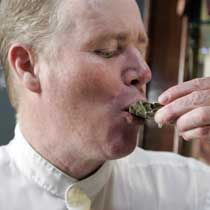Shopping for food is competitive sport in Brisbane.
There are bargains to be had, but limited by geography – I’m on a bicycle – time and seasonality.
And the prices change almost daily for no apparent reason other than supply and demand.
The majority of Australians hate the megalomart duopoly of Coles and Woolworths but within a 2-mile radius, I can choose amongst five fruit and veg places, three butchers, three  bakeries, the ubiquitous Coles and Woolworths, and my favorite, the Dutton Park Fish Market.
bakeries, the ubiquitous Coles and Woolworths, and my favorite, the Dutton Park Fish Market.
Dutton Park is a suburb adjacent to the University of Queensland and the fish market is literally a non-descript hole in the wall down and around from a semi-popular restaurant on the way to the uni. They don’t advertise because they have trouble meeting demand. But they do send e-mails saying what’s in and what’s on special.
That gets back to the competitive sport of shopping.
Two days ago the price of oysters went from $15 a dozen to $20 for two dozen. I told Amy we were having oysters, and she invited over a colleague for dinner last night.
We went through 48 oysters, two blue swimmer crabs and some homemade Napoletana leek pizza.
As a man of large appetites, I wanted more. So after early morning swimming lessons for the daughter, Sorenne and I biked off again to visit with Paul the fishmonger (Sorenne likes the live mud crabs, and the fishheads).
Saturday lunch was more oysters, more blue swimmers, and some Hervey Bay scallops, served with a grated, marinated carrot and beet salad.
All this is on my mind because of the recent death of a South Bend, Indiana, man from vibrio after eating raw frozen shrimp.
Health officials interviewed the man’s wife and determined that he had eaten shrimp from a 16-ounce bag of frozen, raw, peeled and cleaned shrimp sold under the Harvest of the Sea brand. Testing on a second bag of the same brand of shrimp found in the man’s freezer determined that it contained the bacteria afflicting the man.
Felger said that bag of shrimp came from a Martin’s Super Markets store in South Bend. The supermarket chain voluntarily pulled the shrimp from its freezers in during the weekend of Feb. 17-18 after learning that it could possibly be contaminated. But the store didn’t issue a voluntary recall to customers until March 3 because they didn’t have all of the information they needed until then, the company’s advertising manager, Dave Mayfield, told WSBT.
He said that once they got the facts, they issued the recall.
Test results confirming the bacteria were in the shrimp were received last Friday, and the next day Martin’s Supermarket emailed its recall notice to South Bend-area media.
Felger said he believes Martin’s Super Markets acted appropriately by pulling the product once they were notified.
I buy the crabs cooked. The oysters and scallops I grill for about 90 seconds, along with a (small) dollop of garlic butter loaded with homegrown basil and rosemary, and a dab of hot sauce. .jpg) I temped a scallop today because I’d never grilled fresh ones before – 140F. Probably a bit high but tasted great.
I temped a scallop today because I’d never grilled fresh ones before – 140F. Probably a bit high but tasted great.
Paul can talk lovingly about his product, I can write food porn about the preparation, but neither of us – nor anyone else – knows which raw seafood might be carrying a dangerous bacterium, virus or parasite. I pay attention to cross-contamination. And I cook seafood, verified using a tip-sensitive digital thermometer.

.jpg) within the oysters. Furthermore, a safe limit for norovirus has not been established.
within the oysters. Furthermore, a safe limit for norovirus has not been established..jpg) purchase, sell or ship oysters from Area 1642 in Apalachicola Bay, Fla. because the oysters may be contaminated with toxigenic Vibrio cholerae serogroup O75.
purchase, sell or ship oysters from Area 1642 in Apalachicola Bay, Fla. because the oysters may be contaminated with toxigenic Vibrio cholerae serogroup O75. cooking will destroy these viruses but many shellfish are eaten raw or only lightly cooked so may still contain viruses when eaten. The FSA and the shellfish industry are continuing to work together to improve methods for removing viruses from live shellfish.”
cooking will destroy these viruses but many shellfish are eaten raw or only lightly cooked so may still contain viruses when eaten. The FSA and the shellfish industry are continuing to work together to improve methods for removing viruses from live shellfish.”.jpg) an outbreak of illness related to eating uncooked Pacific Coast oysters is being caused by a norovirus.
an outbreak of illness related to eating uncooked Pacific Coast oysters is being caused by a norovirus. oysters or exposing open wounds to still-warm Gulf and bay waters.
oysters or exposing open wounds to still-warm Gulf and bay waters. The positive lab results follow reports of 16 people in Oregon, Washington and Massachusetts who got sick after eating the oysters, said Meredith Vandermeer, epidemiologist with the Public Health Division.
The positive lab results follow reports of 16 people in Oregon, Washington and Massachusetts who got sick after eating the oysters, said Meredith Vandermeer, epidemiologist with the Public Health Division.